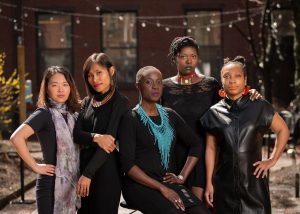I walked away from the corporate world after a decade of practicing law at a multinational business, and I never looked back. I dove into the philanthropic space with curiosity, passion, and a thirst to learn all I could in this new space.
But with time I have recognized the value of looking back. I’ve noted the differences and the similarities between the corporate and philanthropic sectors. Some things are better, but some things are the same. I have learned to embrace the learnings for myself but also for the field of philanthropy.
1. I’ve learned to invest in building the team that I didn’t have and what I didn’t see in the world.

The True Costs Initiative team.
I’ve sat in countless corporate America boardrooms where I was the only woman and the only person of colour. It was exhausting, but more than that, it was sad. Sad because it was clear to me that those who orchestrated these ‘dehydrated rooms’ (as I dubbed them) were denying themselves so much talent, creativity, vision, and expansiveness. So, when given the opportunity to seed, build, and grow my philanthropic organization True Costs Initiative, I knew I needed to build the team I never had and seed an organization that reflected the rich talent I was certain our world has to offer. My bosses, as they do to this day, trusted me, and supported my agency to do exactly that.
So, what does this mean for funders? As funders, we need to proactively seek out and invest in grantee partners and movements that we know are not getting the support and preeminence they deserve and need. Even though much of human rights/ environmental philanthropy purports to be progressive, the lack of diversity on the teams, boards, and at the top levels of the leadership of US grantees still reflects a proclivity to support white-led organizations. Not only do black-led organizations receive on average 24 per cent less revenue than white-led organizations, but black-led organizations also own 76 per cent less in unrestricted assets, with unrestricted funding as the ultimate sign of trust. For all the attention being placed on supporting Indigenous Peoples’ rights, less than one half of one per cent of philanthropic funding goes towards supporting Indigenous Peoples. We in philanthropy talk a good talk about the need for systemic change, but we are hesitant to do that important internal and external transformation that is imperative to making those strides. That means we need to stop talking about supporting groups with diverse and representative leadership and just start doing it. For example, this looks like actively seeking out and supporting black, indigenous, and people of colour-led organizations in their work to hold corporations and parts of the financial sector accountable for continuing to fund, insure, and invest in the oil and gas industries to the detriment of people and the environment.
2. I’ve learned to bring my whole self to work and to not be afraid of being ‘relationship-first’.
In corporate America, I was reticent to do anything that would rock the boat. That manifested itself in an unwillingness to do something as simple as dressing differently. A pop of colour: fine – but not too much! More than that, I was most afraid to express emotion too strongly or share feelings. This was particularly hard as a Caribbean immigrant from a culture where ‘How are you?’ is a genuine inquiry. I often kept feelings at home and muted my intuitive and emotional intelligence. This even when it was clear to me that much of good lawyering was an understanding of the problem clients wanted solved, but most importantly the internal and external stresses they were facing, and the type of advocate they needed me to be in that moment. Muting this instinct and knowledge was a defense mechanism as much as a survival technique in a world that was steeped in formality and emotional distance.
So, what does this mean for funders? As funders, we need to embrace philanthropy that is not metrics or jargon based but ‘relationship first’. This is particularly important in a field where the power dynamics are so imbalanced. Grantee partner relationships thrive best when our grantees know that we care not only about their impact and grant reports, but that we care about their lives, their ways of coping, and their approach to challenges in work and life. I understand that the power dynamic itself is a barrier to fully transparent interactions. That said, for us, our commitment to what I’ve dubbed ‘relationship-first philanthropy’ has proven to be invaluable to deep engagement with our partners and their work. Partners who have cried and laughed with us have inspired us to be the most creative with our programming and approach to philanthropy. Some of our questions and ideas have sparked creative projects, inspired creative litigation and new tranches of work to serve communities better. Greenwatch and Coalition for Human Rights in Development have been inspired to emulate our communication ethos and join us in an unabashed centring of connectivity and love and respect at the core of how we show up in spaces. Our open and trusting relationship with Cultural Survival has enabled us to learn alongside them but also to do some critical internal unlearning. Relationships came first and made for fertile ground for work and impact to thrive.
3. I’ve learned to embrace mistakes and to truly see them as opportunities to learn and ‘unlearn’.
In corporate America I felt like my margin for error was tiny. I didn’t want to be defined by my last mistake but secretly believed that I would be. Regrettably, that meant bringing less creative and innovative thinking to my work because the ‘mistake-proof’ bet was simply to use the mold others always had and to ‘stay in my lane’. On my current team, I have converted that regret into a commitment to saying out loud, often, and genuinely that mistakes are okay, so long as we learn and grow.
What does this mean for funders? As funders, we need to do the same – we need to give (actually, encourage!) grantee partners the space to experiment, grow, and fail. Trust-based philanthropy is the phrase on the lips of so many funders, but we need to think about it as an action. It is what we do that reflects that trust. We truly must view trust as a process, not a destination. Sometimes that means supporting a group that has not totally fine-tuned their communication or advocacy strategy but is moving in the right direction (one driven by the strategies and reflecting the needs of local advocates and communities most affected). Sometimes that means supporting grantee partners by providing technical support, strategic input, communications, and other support in a way that truly accompanies them and their vision. This may look like what funders like SAGE Fund do, seeding new approaches and building knowledge, skills, and capacity to analyze key challenges, fashion strategies in response, and mobilize new coalitions and constituencies. In other cases, it may mean trusting that wins will happen even if they are slow in coming and therefore funding partners and grassroots movements for the long term now in order to secure wins for people and the environment in the future. Finally, it may mean not walking away if the impact that a grantee partner aspired to have didn’t happen for reasons outside of – and even inside of – their control.
Looking back and reflecting like this does not mean that my team, our approach to grantmaking, or our philanthropic ethos is perfect. We’ve made many mistakes. But instead of being defined by those mistakes, we are committed to learning from them, and we give ourselves some grace. As for the broader philanthropic community, this means re-envisioning what leadership, teams, and ‘success’ should look like. It means prioritizing relationships, not jargon. And it means embracing mistakes, not only our own but those of our partners.
Conniel Malek is the Executive Director of True Costs Initiative.
 Upcoming issue: Learning from Failure
Upcoming issue: Learning from Failure
Admitting failures and learning from them contributes to better philanthropy. Yet many foundation boards and staff find it difficult to have conversations about mistakes. This issue of Alliance will explore what it takes to learn from failure with people and organisations who have set out to change not only their practice but also their outlook. Guest edited by Donika Dimovska, Chief Knowledge Officer, the Jacobs Foundation, Switzerland.
Subscribe today to make sure not to miss it!






Comments (3)
Conniel really did a great job. I think not everyone dares to give up many things to follow their passion. Decisive, strong are the words that I want for Conniel.
The approaches Conniel lays out are definitely worthy of emulation. Learning from mistakes is the best way to personally and institutionally grow. I especially like her "relationship first" approach to philanthropy. To Conniel and team, keep up the good work and the proseletizing.
I absolutely loved reading this article. I could literally hear Conniel's voice in my head as i read it. What stood out for me was Conniel's sharp contrast of cooperate America approach and the approach TCI is creating as a culture in their organization and in the work they do. I am all for learning and unlearning because we never stop learning.